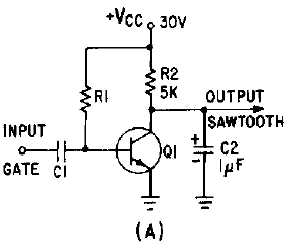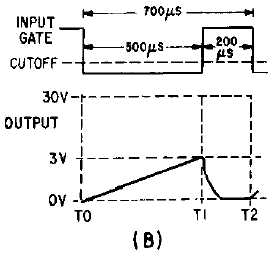3-35
Figure 3-41A.—Transistor sawtooth generator.
Figure 3-41B.—Transistor sawtooth generator.
The amplitude of the sawtooth that is produced is limited by the value of VCC that is used in the
circuit. For example, if the voltage is 30 volts, and the capacitor (C2) is allowed to charge to 10 percent of
30 volts, then the amplitude of the sawtooth will be 3 volts (see figure 3-41, view (B)). If VCC is increased
to 40 volts, C2 will charge to 10 percent of 40 volts and the output will increase in amplitude to 4 volts.
Changing the value of V
CC
in the circuit changes the amplitude of the sawtooth waveform that is
produced; amplitude determines the physical length. Since the number of time constants used in the
circuit has not been changed, linearity does not change with a change in VCC.
The linear slope that is produced by the circuit is dependent on two variables; (1) the time constant
of the RC circuit and (2) the gate length of the gate applied to the circuit. The circuit will produce a linear
sawtooth waveshape if the components selected are such that only one-tenth of 1 TC or less is used. The
GATE LENGTH is the amount of time that the gate is applied to the circuit and controls the time that the
capacitor is allowed to charge. The value of R2 and C2 determines the time for 1 time constant



